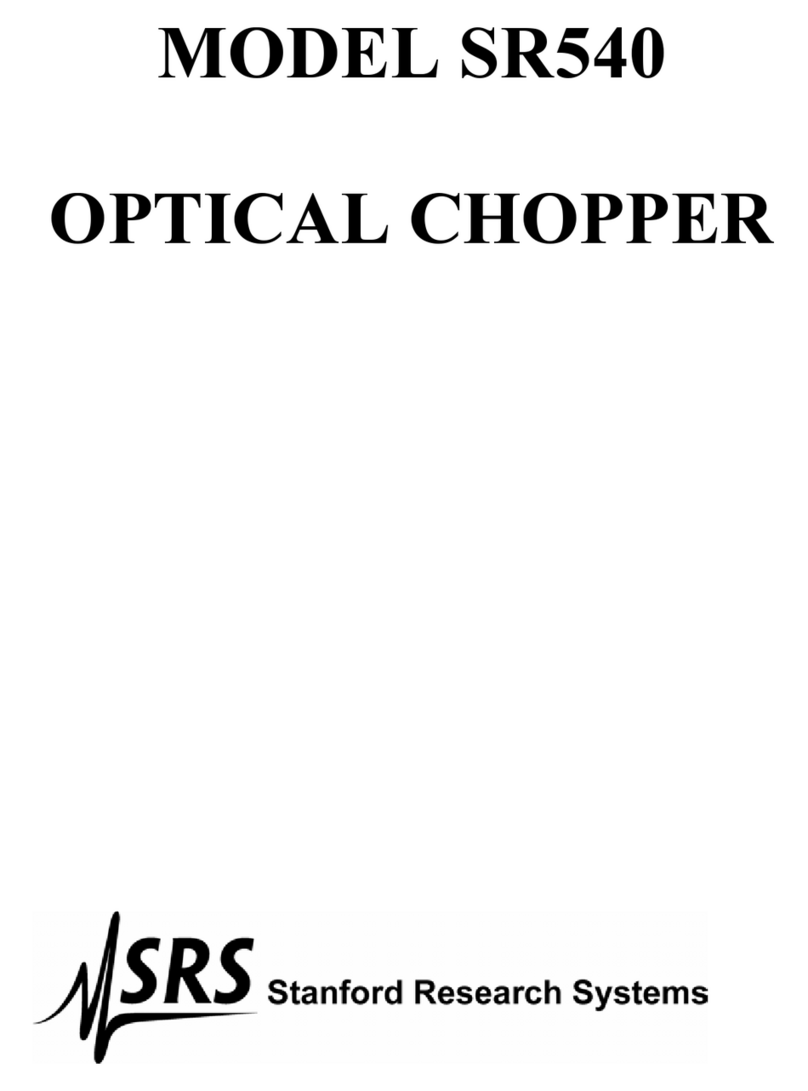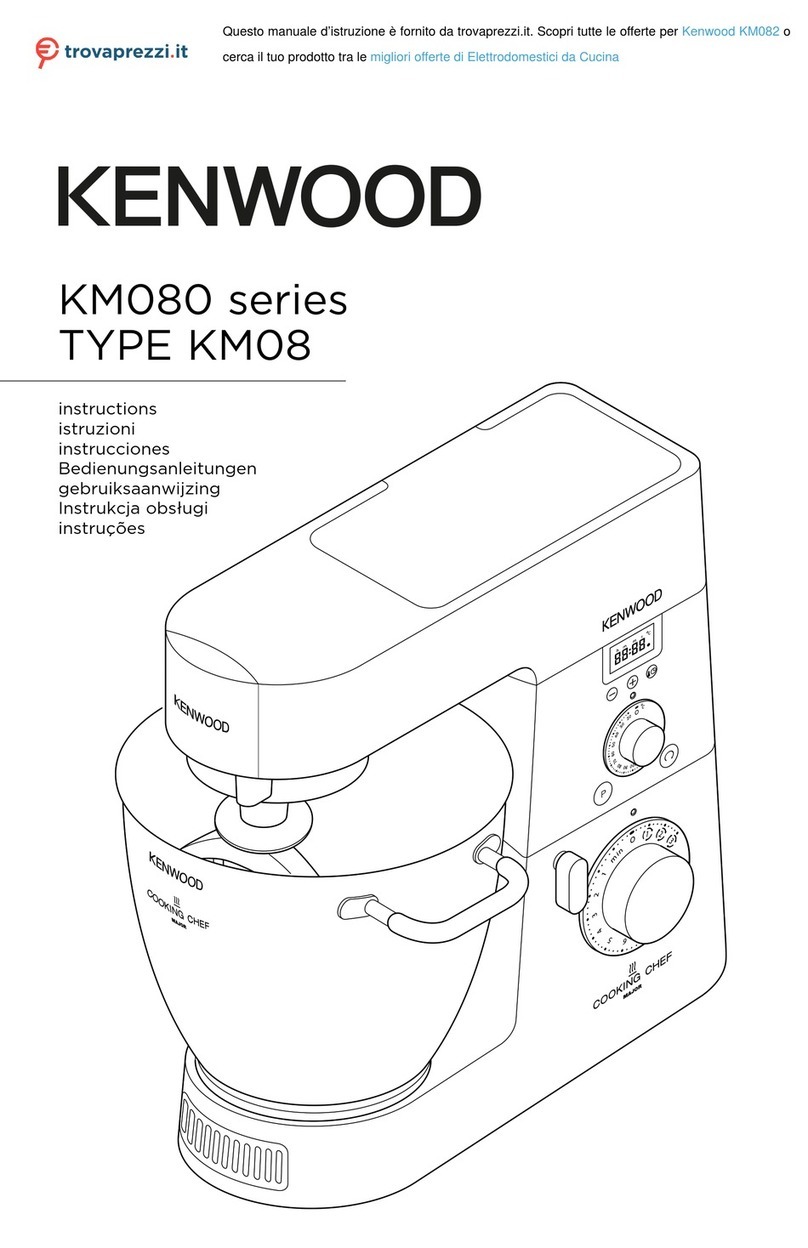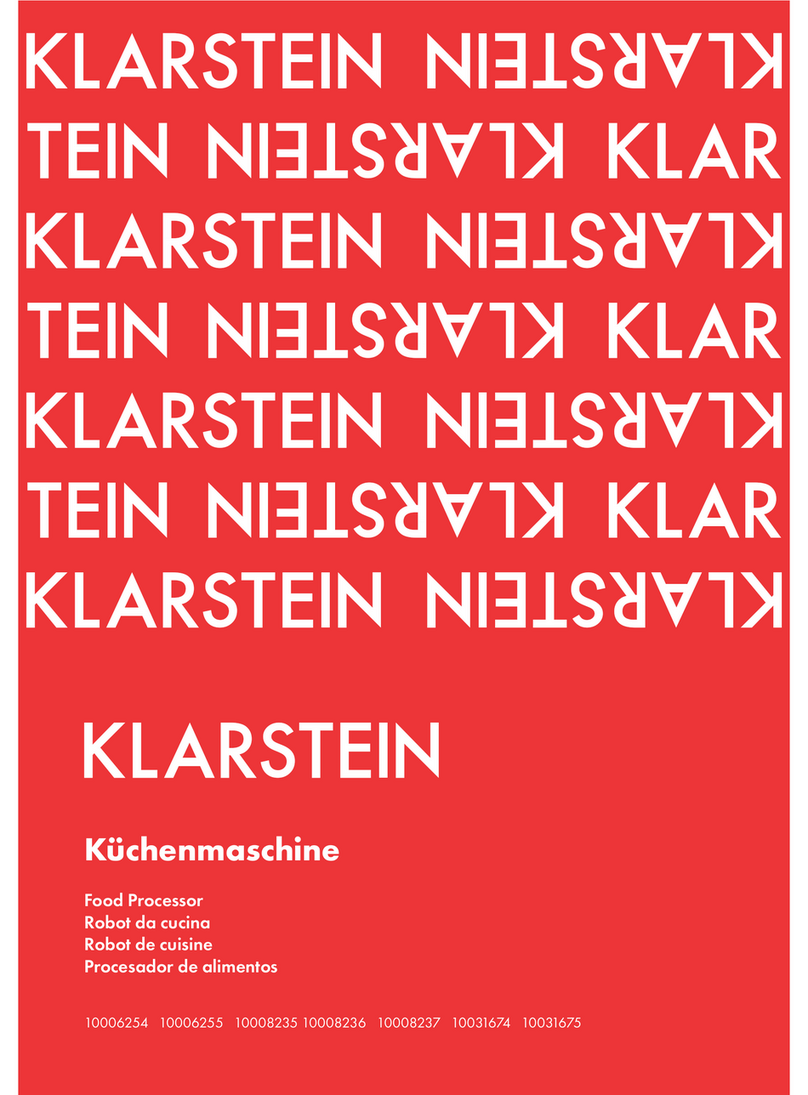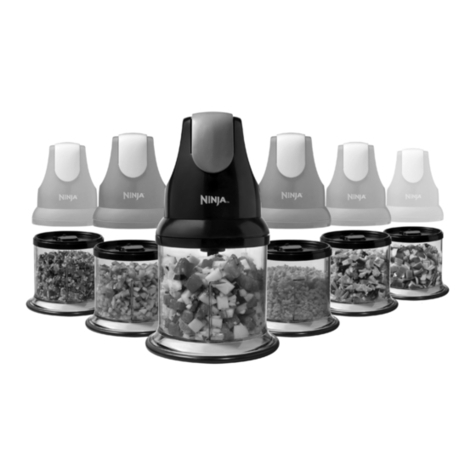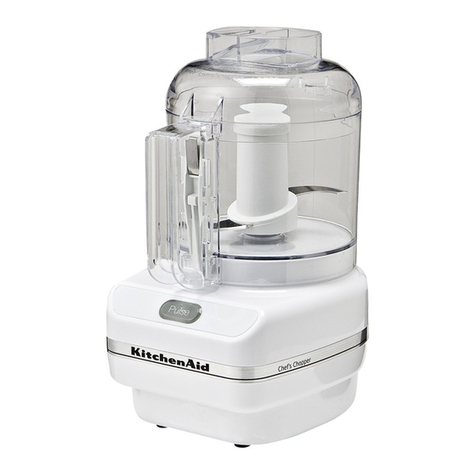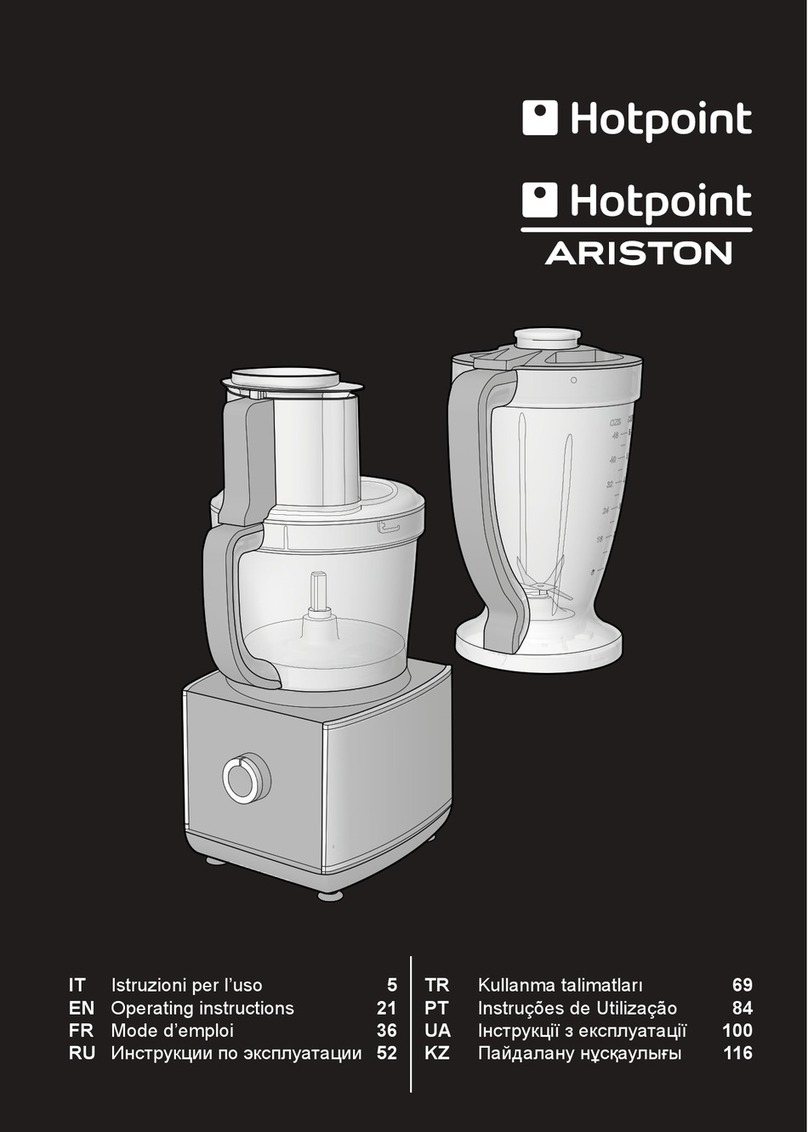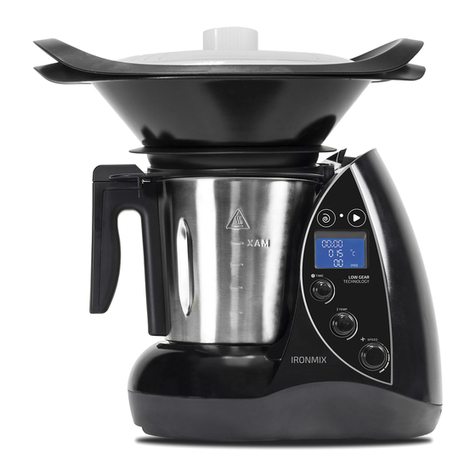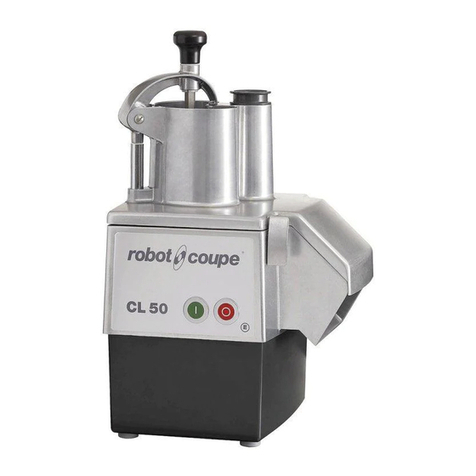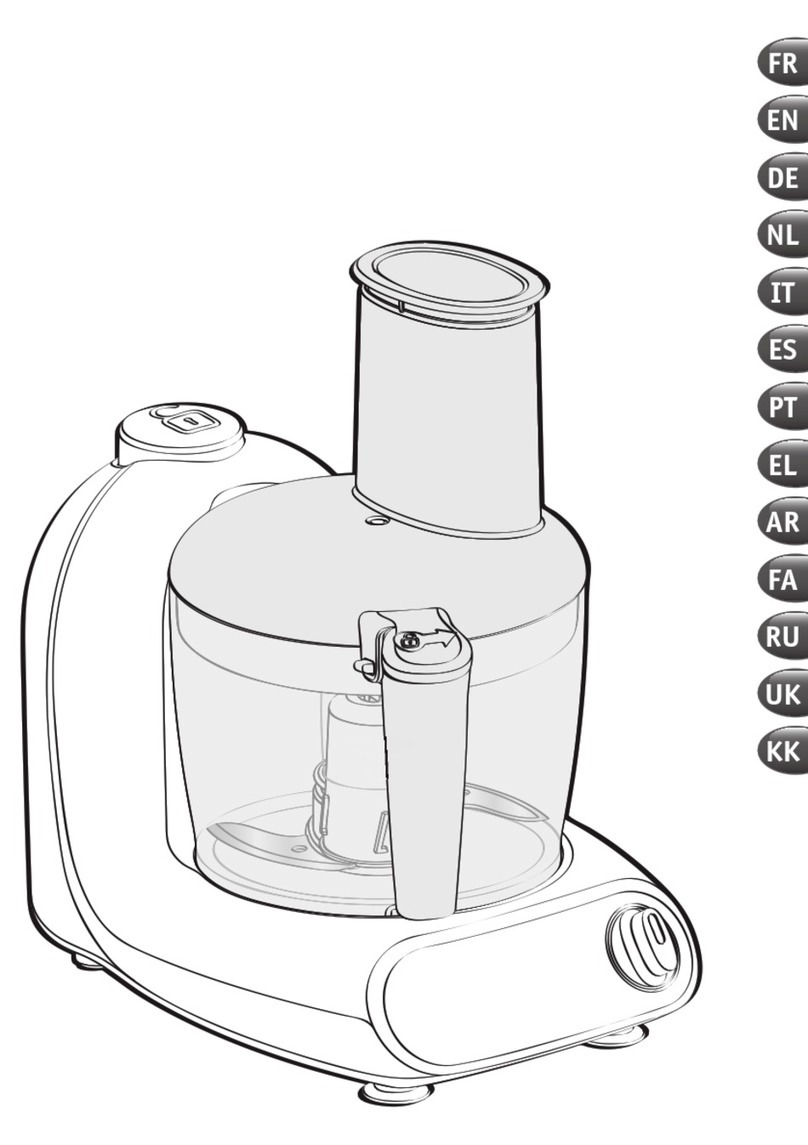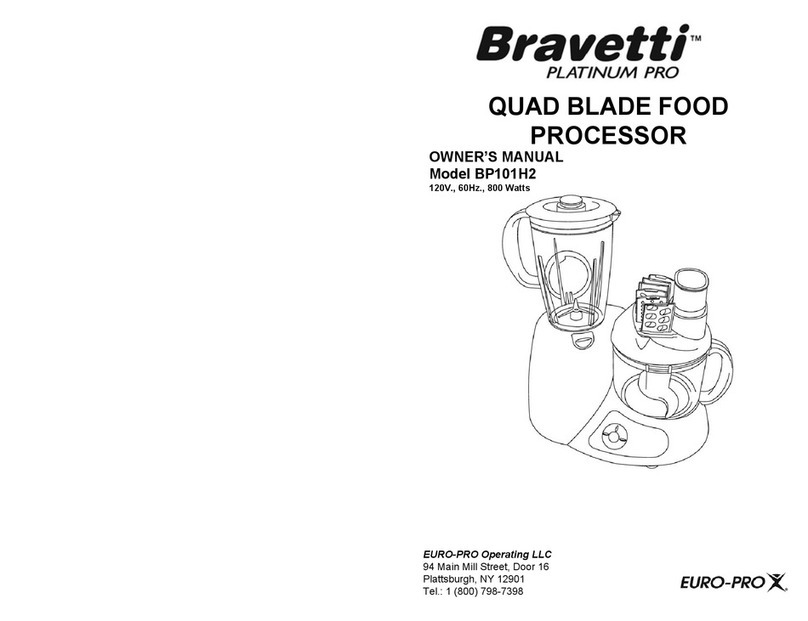SRS Labs SR542 Operation manual

Operation and Service Manual
Precision Optical Chopper
SR542
Stanford Research Systems
Revision 1.0 April 7, 2022

Certication
Stanford Research Systems certies that this product met its published specications at the time of
shipment.
Warranty
This Stanford Research Systems product is warranted against defects in materials and workmanship
for a period of one (1) year from the date of shipment.
Service
For warranty service or repair, this product must be returned to a Stanford Research Systems autho‑
rized service facility. Contact Stanford Research Systems or an authorized representative before re‑
turning this product for repair.
Information in this document is subject to change without notice.
Copyright © Stanford Research Systems, Inc., 2022. All rights reserved.
Stanford Research Systems, Inc.
1290–D Reamwood Avenue
Sunnyvale, CA 94089 USA
Phone: (408) 744‑9040 Fax: (408) 744‑9049
Printed in the U.S.A. Document Number 9‑01764‑903
SR542 Precision Optical Chopper

Contents
General Information 1
Safety and Preparation for Use . . . . . . . . . . . . . . . . . . . 2
ACLineVoltage ........................ 2
LineCord............................ 2
Service ............................. 2
SymbolsontheSR542........................ 3
Notation ............................... 3
Specications............................. 4
Blade Specications . . . . . . . . . . . . . . . . . . . . . . 5
Mechanical Dimensions . . . . . . . . . . . . . . . . . . . . . . . 7
Controller............................ 7
ChopperHead ......................... 8
ChopperBlade......................... 9
1 Geing Started 11
1.1 Using This Manual . . . . . . . . . . . . . . . . . . . . . . . 12
1.2 Quick Start Guide . . . . . . . . . . . . . . . . . . . . . . . 12
1.2.1 Preparations for Use . . . . . . . . . . . . . . . . . . 12
1.2.2 Lock to Internal Frequency . . . . . . . . . . . . . . 13
1.2.3 Lock to External Frequency . . . . . . . . . . . . . . 14
1.2.4 Use with a Lock‑In Amplier . . . . . . . . . . . . . 15
2 Operation 17
2.1 Functional Overview . . . . . . . . . . . . . . . . . . . . . . 18
2.1.1 Chopper Control Loop . . . . . . . . . . . . . . . . 18
2.1.2 ChopMode.......................20
2.1.3 ShuerMode......................23
2.2 Front Panel Control . . . . . . . . . . . . . . . . . . . . . . 25
2.2.1 Power..........................25
2.2.2 Numeric Display . . . . . . . . . . . . . . . . . . . . 25
2.2.3 Conguration . . . . . . . . . . . . . . . . . . . . . 28
2.2.4 Display/Adjust . . . . . . . . . . . . . . . . . . . . . 30
2.2.5 Numeric Entry . . . . . . . . . . . . . . . . . . . . . 31
2.2.6 Phase ..........................32
2.2.7 Motor..........................32
2.2.8 Setup ..........................33
2.3 Rear Panel Connections and Signals . . . . . . . . . . . . . 35
2.3.1 Source Inputs and Output . . . . . . . . . . . . . . . 36
2.3.2 Reference Outputs . . . . . . . . . . . . . . . . . . . 37
2.3.3 Synthesized Outputs . . . . . . . . . . . . . . . . . 37
i SR542 Precision Optical Chopper

ii Contents
3 Remote Operation 39
3.1 List of Commands by Subject . . . . . . . . . . . . . . . . . 40
3.2 List of Commands by Name . . . . . . . . . . . . . . . . . 42
3.3 Introduction ..........................44
3.3.1 Interface Conguration . . . . . . . . . . . . . . . . 44
3.3.2 Remote Interface Buers . . . . . . . . . . . . . . . 44
3.4 Commands...........................44
3.4.1 Command Syntax . . . . . . . . . . . . . . . . . . . 44
3.4.2 Notation ........................45
3.4.3 Examples........................45
3.4.4 Conguration Commands . . . . . . . . . . . . . . 46
3.4.5 Chopper Operation Commands . . . . . . . . . . . 49
3.4.6 Setup Commands . . . . . . . . . . . . . . . . . . . 50
3.4.7 Interface Commands . . . . . . . . . . . . . . . . . 52
3.4.8 Status Commands . . . . . . . . . . . . . . . . . . . 54
3.5 StatusModel ..........................57
3.5.1 Status Byte (SB) Register . . . . . . . . . . . . . . . 58
3.5.2 Service Request Enable (SRE) Register . . . . . . . . 58
3.5.3 Standard Event Status Register (ESR) . . . . . . . . 59
3.5.4 Standard Event Status Enable (ESE) Register . . . . 59
3.5.5 Chopper Status (CHCR/CHEV) Registers . . . . . . 60
3.6 ErrorCodes...........................62
3.6.1 Command Execution Errors . . . . . . . . . . . . . 62
3.6.2 Command Parsing Errors . . . . . . . . . . . . . . . 63
3.6.3 Communication Errors . . . . . . . . . . . . . . . . 63
3.6.4 Motor Errors . . . . . . . . . . . . . . . . . . . . . . 64
3.6.5 Device‑Dependent Errors . . . . . . . . . . . . . . . 64
3.6.6 Other Errors . . . . . . . . . . . . . . . . . . . . . . 64
4 Applications 65
4.1 Single Beam Experiment . . . . . . . . . . . . . . . . . . . . 66
4.2 Dual Beam Experiment . . . . . . . . . . . . . . . . . . . . 67
4.3 Detection at Sum and Dierence Frequencies . . . . . . . . 68
5 Troubleshooting 69
5.1 Chopper Head Cable Shield Grounding . . . . . . . . . . . 69
Index 71
SR542 Precision Optical Chopper

General Information
Safety and Preparation for Use . . . . . . . . . . . . . . . . . 2
ACLineVoltage ....................... 2
LineCord........................... 2
Service ............................ 2
Symbols on the SR542 . . . . . . . . . . . . . . . . . . . . . . 3
Notation .............................. 3
Specications ........................... 4
Blade Specications . . . . . . . . . . . . . . . . . . . . . 5
Mechanical Dimensions . . . . . . . . . . . . . . . . . . . . . 7
Controller........................... 7
ChopperHead ........................ 8
ChopperBlade........................ 9
1 SR542 Precision Optical Chopper

2General Information
Safety and Preparation for Use
WARNING
Dangerous voltages, capable of causing injury or death, are present in
this instrument. These voltages can persist for many minutes after AC
power is removed. Do not remove the product covers or panels. Do
not apply power or operate the product without all covers and panels
in place.
CAUTION
This product employs a motor capable of turning at high speeds. The
rotating blade poses injury risk. Rotating parts also pose an entangle‑
ment hazard for loose clothing or long exposed hair. To prevent acci‑
dental personal injury or damage to the instrument, secure the included
shroud over the chopper blade before operation.
AC Line Voltage
The SR542 Precision Optical Chopper operates from a 90 V–250 V nom‑
inal AC power source having a line frequency of 50 Hz or 60 Hz.
Line Cord
The SR542 Precision Optical Chopper has a detachable, three‑wire
power cord for connection to the power source and to a protective
ground. The chassis of the instrument is connected to the outlet ground
to protect against electrical shock. Always use an outlet which has a
properly connected protective ground.
Service
The only user‑serviceable part inside the chassis is jumper J503, for se‑
lection of ground connection of the 10P10C chopper head cable shield.
Please refer to Section 5.1 for instructions. Do not aempt to service or
adjust this instrument unless another person, capable of providing rst
aid or resuscitation, is present. The SR542 Precision Optical Chopper
otherwise does not have any user serviceable parts inside. Refer service
to a qualied technician.
Do not install substitute parts or perform any unauthorized modica‑
tions to this instrument. Contact the factory for instructions on how to
return the instrument for authorized service and adjustment.
SR542 Precision Optical Chopper

Symbols on the SR542 3
Symbols on the SR542
Warning Risk of electric shock. Injury or death is possible
if the instructions are not obeyed.
Caution Refer to user manual. Damage to the instrument
or other equipment is possible.
Caution Injury is possible due to rotating parts.
Power Toggle instrument power.
Chassis
Ground
Notation
Typeseing conventions used in this manual, with examples of each.
Use case Example
Front‑panel buons Run /
Stop
Front‑panel text Locked ,Int Freq ,Source
Remote command names *IDN?
Literal text (sent) *IDN?
Literal text (received) Stanford_Research_Systems,SR542,s/n00000001,v1.0.0
SR542 Precision Optical Chopper

4General Information
Specications
Frequency
Shaft shaft Hz to Hz
Chop slots shaft Hz to Hz (2‑slot blade)
Hz to kHz (10/100‑slot blade)
Sources (4) Internal Clock, VCO, AC Line, Ext Sync
Accuracy ±20 ppm
Stability ±20 ppm/year
Resolution 6 digits
Multiplier, ninteger, 1–200
Divisor, minteger, 1–200
Phase
Resolution
Jier (opt, rms)
(preliminary)
Slot Count at min at min at max
2(Hz) (Hz) (Hz)
5(Hz) (Hz) (kHz)
6(Hz) (Hz) (kHz)
10 (Hz) (Hz) (kHz)
25 (Hz) (Hz) (kHz)
30 (Hz) (Hz) (kHz)
100 (Hz) (Hz) (kHz)
jitter opt jitter μs
chop period μs360opt
Inputs (2 BNCs)
Impedance M
VCO Voltage 0 to +10 V dc
VCO Accuracy (typ.) ±100 ppm
Ext Sync TTL Minimum 2 V logic level
Ext Sync Sine 100 mV rms to 1 V rms signal, AC‑coupled (>1 Hz)
Edge Trigger TTL Rising, TTL Falling, or Sinusoidal
Outputs (6 BNCs)
Voltage 0 V to +5 V logic levels, sourced through
Signals Source, Shaft (1 PPR), Inner Slots, Outer Slots,
Sum OUTER INNER, Dierence OUTER INNER
Operation
Control Modes Chopping: synchronize Shaft, Inner, or Outer to source
Shuer: xed angular position
Remote Interface USB type B receptacle; serial port emulation, 115,200 baud
Temperature +C to +C
Power <W, 90–250 Vac, 50/60 Hz
Dimensions
Controller 8.3” 4.1” 9.2” (WHL)
Head with Shroud 4.31” 4.65” 3.75” (WHL)
Weight
Controller 4.6 lbs
Head with Shroud 1.2 lbs
SR542 Precision Optical Chopper

Specications 5
Blade Specications
The chopper blades designed for the SR542 are chemically etched for
precision tolerancing of the beam apertures. The blade outer diameter is
4” and thickness is 0.010”. For detailed dimensioning, see Figure 4. For
dual‑frequency blades with two tracks of slots (apertures), the tracks are
referred to throughout this manual as “inner” and “outer.” Note that the
inner track is duplicated near the outermost circumference of the blade
so that the corresponding sloed opto‑interrupter on the chopper head
can detect the inner slots.
Table 1: Available chopper blades. For dual‑frequency blades, the inner and outer number of slots and maximum
beam diameter are indicated as (Inner/Outer). O542DF is a variable duty factor blade, with available duty cycles
from 10‑90%.
Part Num Num Slots Max Beam Diam (in) Chop Frequency Range (Hz)
O5422 2 1.150 0.4 – 400
O5425 5 0.873 1 – 1 k
O54230 30 0.184 6 – 6 k
O54256 5 / 6 0.626 / 0.500 1 – 1.2 k
O5422530 25 / 30 0.157 / 0.184 5 – 6 k
O54210100 10 / 100 0.358 / 0.057 2 – 20 k
O542DF 6 0.128 1.2 – 1.2 k
SR542 Precision Optical Chopper

6General Information
O54256 5/6 Slot O5422530 25/30 Slot O54210100 10/100 Slot
O542DF Variable Duty (10%–90%)
O5422 2 Slot O5425 5 Slot O54230 30 Slot
Figure 1: Available chopper blades for the SR542. Max beam size for outer (red) and inner (blue) tracks are listed
in Table 1. The variable duty factor blade permits selection of duty factor from 10% to 90% in 10% increments
depending on the radial placement of the beam spot.
SR542 Precision Optical Chopper

Mechanical Dimensions 7
Mechanical Dimensions
Controller
PROJECT
TITLE
DRAWN
CHECKED
APPROVED
SCALE WEIGHT SHEET
DWG NO REVCODESIZE
1/11:1
3/16/2022Andy Berger
B
SR540 Redesign
asm_top_level_sr542_asm
4.1
8.1
8.3
0.6
8.1
9.2
(a) LEFT
PROJECT
TITLE
DRAWN
CHECKED
APPROVED
SCALE WEIGHT SHEET
DWG NO REVCODESIZE
1/11:1
3/16/2022Andy Berger
B
SR540 Redesign
asm_top_level_sr542_asm
4.1
8.1
8.3
0.6
8.1
9.2
(b) FRONT
Figure 2: Dimensions (in inches) of the SR542 controller.
SR542 Precision Optical Chopper

8General Information
Chopper Head
PROJECT
TITLE
DRAWN
CHECKED
APPROVED
SCALE WEIGHT SHEET
DWG NO REVCODESIZE
1/31:1
3/16/2022Andy Berger
B
SR540 Redesign
SR542 Assembly
4.31
4.65
0.25
0.28
2.70
4.76
3.75
1.89
1.33
Ø0.51
3.1
2.00
Ø0.26
Ø3.70
Ø2.80
Ø2.55
Ø1.53
Chopper Blade
0.40
(a) LEFT
PROJECT
TITLE
DRAWN
CHECKED
APPROVED
SCALE WEIGHT SHEET
DWG NO REVCODESIZE
1/31:1
3/16/2022Andy Berger
B
SR540 Redesign
SR542 Assembly
4.31
4.65
0.25
0.28
2.70
4.76
3.75
1.89
1.33
Ø0.51
3.1
2.00
Ø0.26
Ø3.70
Ø2.80
Ø2.55
Ø1.53
Chopper Blade
0.40
(b) FRONT
PROJECT
TITLE
DRAWN
CHECKED
APPROVED
SCALE WEIGHT SHEET
DWG NO REVCODESIZE
1/31:1
3/16/2022Andy Berger
B
SR540 Redesign
SR542 Assembly
4.31
4.65
0.25
0.28
2.70
4.76
3.75
1.89
1.33
Ø0.51
3.1
2.00
Ø0.26
Ø3.70
Ø2.80
Ø2.55
Ø1.53
Chopper Blade
0.40
(c) TOP
Figure 3: Dimensions (in inches) of the SR542 chopper head.
SR542 Precision Optical Chopper

Mechanical Dimensions 9
Chopper Blade
The SR542 is compatible with custom custom designs. Figure 4 presents
the critical dimensions for compatibility with the chopper hub and
opto‑interrupters. Single‑track designs are also supported, for which
the outermost aperture track is not needed. The chopper blade thick‑
ness should not exceed 0.050 in to maintain proper clearance from the
sloed opto‑interrupters. However, motion control is optimized for
0.010 in stainless steel blades.
The SR542 is also backwards‑compatible with SR540 chopper blades.
However, due to dierences in the outermost aperture track, the Inner
Slots Ref Out waveform, inner slots frequency, and inner slot count will
be incorrect. This will also aect the sum and dierence frequency out‑
puts.
Performance specications are not guaranteed for custom or SR540
chopper blades.
Ø4.00
Ø0.502
Ø1.000 B.C.
Ø0.12 (3 plcs)
clearance slots (or holes) for 4-40
Ø3.95
Ø3.75
Ø3.70
Ø2.70
Ø2.65
Ø1.40
40.00°
Figure 4: Dimensions (in inches) for the dual‑track chopper blade.
SR542 Precision Optical Chopper

10 General Information
SR542 Precision Optical Chopper

1 Getting Started
This chapter provides step‑by‑step instructions to get started quickly
with the SR542 Precision Optical Chopper. Refer to Chapter 2 for more
detailed explanations of the features of the SR542.
1.1 Using This Manual . . . . . . . . . . . . . . . . . . . . . 12
1.2 Quick Start Guide . . . . . . . . . . . . . . . . . . . . . . 12
1.2.1 Preparations for Use . . . . . . . . . . . . . . . . . 12
1.2.2 Lock to Internal Frequency . . . . . . . . . . . . . 13
1.2.3 Lock to External Frequency . . . . . . . . . . . . . 14
1.2.4 Use with a Lock‑In Amplier . . . . . . . . . . . . 15
11 SR542 Precision Optical Chopper

12 1 Geing Started
1.1 Using This Manual Two possible starting points are available to new users of the SR542.
Users who wish to jump in and begin using the SR542 immediately
should continue with this chapter. A series of step‑by‑step procedures
are given for basic operation of the instrument in Section 1.2.
Those who prefer to learn the features of the SR542 with greater depth
should turn to Chapter 2: Operation.
Chapter 3: Remote Operation discusses remote operation of the SR542
over the USB interface.
Chapter 4: Applications provides experimental use cases for the SR542.
Chapter 5: Troubleshooting oers troubleshooting guides for possible
issues that you may encounter with the SR542.
1.2 Quick Start Guide
1.2.1 Preparations for Use To perform the steps described in this section, you will need:
• SR542 controller and AC line cord
• SR542 chopper head and blade
• SR542 10‑conductor chopper head cable
1. If a blade is not already installed, mount a blade onto the chopper
hub. Be careful to slide the blade into the sloed opto‑interrupters
near the base before positioning the blade’s inner diameter onto
the hub. Secure the blade by sandwiching it between the hub and
the hub plate and fasten using three 4‑40 at‑head screws.
2. It is recommended to secure the chopper head before running the
motor. Bolt the chopper head to the optical table using the slots in
the base plate, or using a 1/2” optical post and the clamping knob.
3. Plug the AC line cord into the rear‑panel power entry module of
the controller and then into a grounded wall outlet.
4. Connect the included 10‑conductor chopper head cable to the rear
panel of the control unit and then to the chopper head.
CAUTION Do not use a typical 8‑conductor RJ45 ethernet cable to connect the con‑
trol unit to the chopper head.
5. Slide the shroud over the chopper blade and secure using two 4‑40
pan‑head screws.
CAUTION To prevent accidental personal injury or damage to the instrument, se‑
cure the included shroud over the chopper blade before operation.
SR542 Precision Optical Chopper

1.2 Quick Start Guide 13
1.2.2 Lock to Internal Frequency
The steps below will demonstrate how to run the optical chopper, lock‑
ing the chopper blade to the controller’s internal frequency generator.
Beginning with the SR542 controller connected to the chopper head with
the included cable and to AC power (as in Section 1.2.1):
1. Power on the control unit by pressing .
Most instrument seings are retained in non‑volatile memory.
Upon power‑on, these seings are restored to their values from
before the power was turned o.
2. Restore the factory‑default conguration by pressing Recall , fol‑
lowed by 0, and nally .
3. Select the Control track corresponding to the track of slots that
will be used (Inner or Outer). Press Control
Shaft to toggle between Inner
and Outer tracks. Press and hold Control
Shaft to select Shaft .
4. Change the internal frequency by pressing and until
the Int Freq indicator is illuminated. Press 7+5+.
+0+ to set the Internal Frequency to Hz.
5. When the desired conguration is established, press Run /
Stop to run
the chopper motor. A long (1 s) press is required to start the
motor.
On startup, the SR542 rst searches for the rotor shaft index, then spins
the motor shaft several times to survey the installed blade before pro‑
ceeding to the as‑congured control parameters (frequency and phase).
The Source Output on the rear‑panel outputs a 5 V square wave (TTL)
at the selected Source frequency (in this case Internal Freq ). When the
motor is running, three additional outputs are available: Outer Slots Ref
Out,Inner Slots Ref Out, and Rotor Shaft Ref Out. Finally, once the chop‑
per is phase locked, the sum frequency OUTER INNERand dierence
frequency OUTER INNERoutputs are available.
When the selected control track comes into frequency lock with the in‑
ternal frequency reference, the green Chopper Locked LED will begin
to ash, and the orange Chopper Unlocked LED will remain illumi‑
nated. Upon acquisition of a stable phase lock with the reference, the
green Chopper Locked LED will become steadily illuminated, and the
Chopper Unlocked LED will turn o.
SR542 Precision Optical Chopper

14 1 Geing Started
1.2.3 Lock to External Frequency
In this example the Ext Sync Input will be used to synchronize the optical
chopper to an external reference.
To perform the steps in this section, in addition to the setup from the
previous section you will need:
• an external frequency source, such as a function generator, or the
reference output of a lock‑in amplier.
Beginning with the setup described in Section 1.2.1:
1. Press to turn on the SR542.
2. Connect the external reference signal to the Ext Sync Input connec‑
tor on the rear panel using a standard BNC cable (not included).
3. Press Source
Int repeatedly to until Ext Sync is selected as the source.
4. Press Edge repeatedly to select the desired edge triggering. Select
or for a TTL reference, or for a sinusoidal reference.
For TTL inputs, a minimum >2V logic level is required. For sinu‑
soidal inputs, an amplitude of at least 100 mV rms and frequency
greater than 1 Hz is required.
The Locked indicator should illuminate within about three peri‑
ods of the reference frequency. If Locked does not light or does
not remain lit, check the quality of the external signal.
5. Use and to show the Source frequency monitor on
the numeric display and verify that the frequency matches that of
the external reference.
6. Congure the Control track by pressing Control
Shaft until the desired
track is selected. To select Shaft , press and hold Control
Shaft .
7. Press and hold Run /
Stop until the motor starts.
The Locked indicator should remain lit and the Chopper Locked
indicator will begin to ash indicating the motor has achieved the
correct speed, and then light solid once the phase is locked.
8. Change the frequency of the external source by a few percent.
The Locked light will go out indicating that the internal clock is
no longer locked to the external frequency. Until the internal clock
can lock to the new frequency, the chopper will continue to run at
the previous frequency and Chopper Locked may remain lit.
Once both Locked and Chopper Locked indicators are lit, the chop‑
per is properly phase locked to the external reference.
SR542 Precision Optical Chopper

1.2 Quick Start Guide 15
1.2.4 Use with a Lock-In Amplier
The SR542 can be used with a lock‑in as a follower or a reference. To follow
the lock‑in, simply connect the reference output from the lock‑in to the
Ext Sync Input of the SR542 as described above in Section 1.2.3: Lock
to External Frequency. Alternatively, the lock‑in can follow the SR542
as described here. In this example, Outer Slots Ref Out is used as the
reference signal input to the lock‑in amplier.
To perform the steps in this section, in addition to the setup from the
previous sections you will need:
• a lock‑in amplier (e.g. SR860)
• a light source (optional)
• a photodiode, phototransistor, or other light‑sensitive detector
Beginning with the setup described in Section 1.2.1:
1. Select Internal Freq as the Source by pressing Source
Int repeatedly.
2. Select Outer as the Control by pressing Control
Shaft repeatedly.
3. Set the internal frequency to 75 Hz by selecting Int Freq with
and and then entering 7+5+ .
4. Connect the Outer Slots Ref Out from the rear panel of the SR542 to
the reference input of the lock‑in amplier using a standard BNC
cable (not included).
5. Congure the lock‑in reference seings to use an external refer‑
ence with TTL input and 50 termination, if available.
The Outer Slots Ref Out signal is derived from an opto‑interrupter
and is not available until the chopper is running. As a result, the
lock‑in amplier will not yet be able to lock to this signal.
6. Press and hold Run /
Stop until the chopper starts.
Now the lock‑in amplier should be able to lock to the Outer Slots
Ref Out signal.
7. Connect the photodiode to the lock‑in input and position the pho‑
todiode lens near the chopper blade.
A light source, such as a laser, can be used to illuminate the pho‑
todiode detector through the chopper blade but ambient light can
often produce a large enough signal if the detector is placed very
close to the blade.
SR542 Precision Optical Chopper

16 1 Geing Started
8. Adjust the lock‑in sensitivity until a signal is visible.
The lock‑in is measuring the component of the photodiode signal
at the frequency provided by the Outer Slots Ref Out. This signal is
produced by the taller opto‑interrupter at the base of the chopper
head. Because the photodiode is at a dierent position from the
interrupter, there will be a phase dierence of detector
oset, where is the integer number of slots between the opto‑
interrupter and the photodiode.
In most cases it is desirable to adjust for oset (the term
can be neglected). This can be achieved by adjusting the phase on
the lock‑in.
9. Adjust the phase of the lock‑in so that the entire signal appears on
the rst channel (Ch 1 or on most two‑phase lock‑ins). On the
SR860 lock‑in, simply press Auto
Phase .
The phase dierence between the photodetector and the opto‑
interrupter signals is a result of the relative physical positions of
those detectors around the chopper blade and cannot be adjusted
by a seing on the SR542. Increasing the phase seing of the
SR542 does advance the phase of the photodetector signal, but it
advances the phase of the opto‑interrupter signal—used by the
lock‑in as its reference—by an identical amount.
10. Set the Phase of the SR542 to 15and notice that the signal on the
lock‑in does not change.
11. Set the Phase of the SR542 to 0.
12. Now disconnect the BNC cable from the Outer Slots Ref Out and
connect it instead to the Source Output.
The phase of the lock‑in signal is now oset by the phase dier‑
ence between the Source Output and the opto‑interrupter.
13. Change the Phase of the SR542 and notice that the same change
appears on the lock‑in.
Source Output provides a signal with the same average frequency as the
selected Control track and its corresponding rear panel output (Outer
Slots Ref Out or Inner Slots Ref Out), so long as the Multiplier is set for
1. However, the signals produced by the opto‑interrupters (Outer
Slots Ref Out and Inner Slots Ref Out) are the most accurate representa‑
tions of the modulation imposed on a beam path through the outer and
inner tracks, respectively. Therefore, it can be advantageous to use these
outputs as the lock‑in reference input.
SR542 Precision Optical Chopper
Table of contents
Other SRS Labs Food Processor manuals
Popular Food Processor manuals by other brands
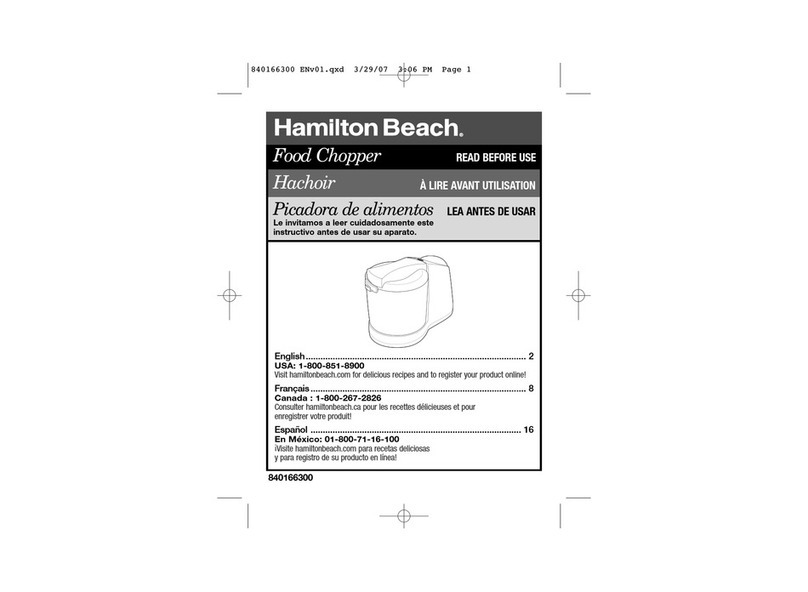
Hamilton Beach
Hamilton Beach 840166300 Use & care guide

KitchenSmith
KitchenSmith 12078 Instruction manual and recipe guide

Moulinex
Moulinex Odacio 3 Instructions and recipes

Myria
Myria MY4069 instruction manual

Braun
Braun Multipractic UK 285 use instructions
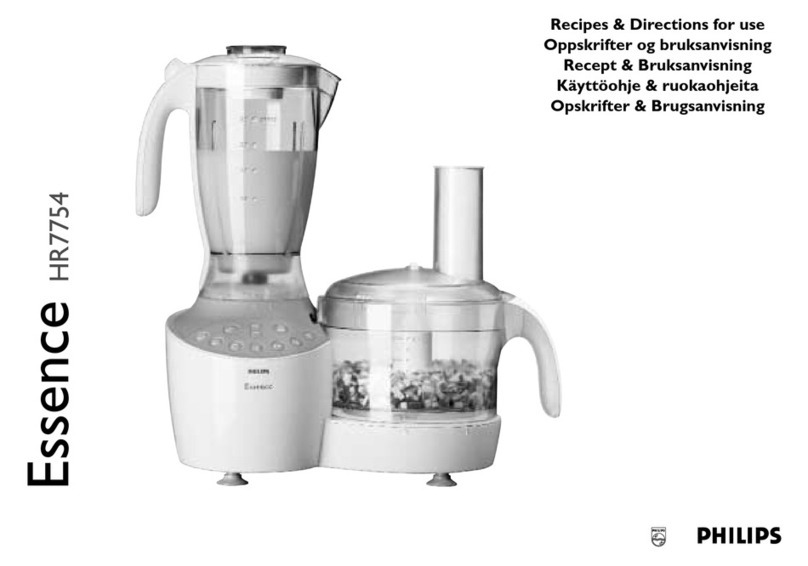
Philips
Philips Essence HR7754 Recipes & directions for use
